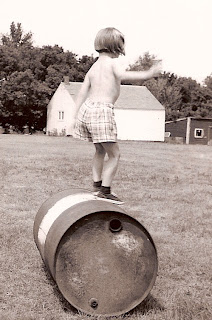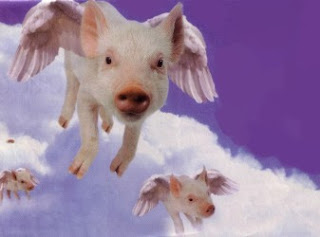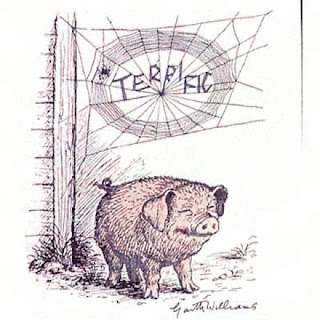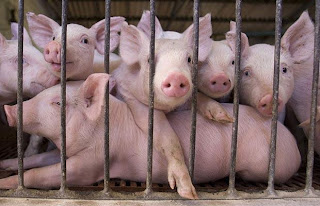In June 2011, an enormous hog farm blew sky-high, killing 1500 hogs outright and damaging the reputation of the industry. Interviewed at the site of the blast, the manager kicked through an ankle-deep deposit of cracklins and stared up at the sky with regret. “If the fins in the ventilation system had only held, our entire product might have rained down as chops,” he said, but such was not the case; the barn was destroyed. A fine particulate cloud of Baco-Bits is believed to have traveled around the world twice, affecting sunsets for days. The precise cause of the explosion remains a mystery. Hog industry spokesmen are at a loss to explain what they describe as a “sudden highly localized reversal-of-gravity incident.” A local band of parishioners calling themselves Holy Pisspots Of The Lord has determined that the explosion was evidence of God’s wrath over something or other, and has set up a preliminary picket nearby with blank signs until they narrow down the list of society’s transgressions. But local scientists are fingering the poop. Contacted several miles upwind, Dr. Sneedwit from the county extension service explained that a full test of the hog poop lagoon will have to wait until he gets a fresh undergraduate, or until the return of the lagoon maintenance crew, Darryl, who is still in the hospital awaiting an eyebrow transplant. Nonetheless, he was confident that the culprit was the notorious Gray Foam in the poop lagoon, the result of a massive buildup of bacteria farts, set off by a spark. “It’s not the fault of the bacterium,” he said. “If you or I fell into a giant vat of cheese fondue, we’d eat our way out, too.”
 |
| Another ill-advised stunt on the farm |
The danger of a concentrated poop pile is real. My grandma’s farm in North Dakota had a repository confined by an old building foundation and Uncle Cliff regularly stocked it with fresh cow pies. This was the site of the first flowering of several of my personal hallmarks, including an attraction to poop and a tendency to tip over. I do recall trying to balance on the old foundation, and the next thing the adults know, there was a “ploop” sound followed by the sight of a small, dark, tragically encrusted figure staggering over the landscape, wailing like a tornado siren. I needed comfort, soap, and the loving arms of my mother, but instead I was hosed down in the front yard to the accompaniment of more laughter than is customary for Lutherans.
The situation can only be more dire in the case of the modern hog factory. The 2011 incident was not an isolated one. Gray foam explosions have been reported in several locations of great hog concentration, but the industry remains proud of its contribution to the American food supply. “Thanks to our modern methods, pork is incredibly cheap,” a spokesman said. “In some regions, some very fine butt can be had for pennies.” This happy circumstance is due to efficiencies of scale. Whereas pigs used to be raised on small family-run farms by picturesque workers in overalls and a feed store cap, swinging a slop bucket, these have been almost entirely replaced by the mega-piggery. The modern hog farm business model has thus been credited with relieving thousands of individuals from honest labor. And each factory is capable of producing a half-billion tons of ham a year from an average of two thousand proto-meat units after a brief interim still referred to colloquially as “life.”
Great strides have been made in redefining humane treatment. The proto-meat units are wedged in together under one roof, where they are protected from sunburn; they are administered antibiotics without co-pay; the young meat units are thoughtfully confined to their own crate, which protects them from being crushed if the mother-unit attempts to roll over in hers. Industry analysts are looking into methods of further enhancing proto-meat unit density in the barns by the topical application of Spam jelly for lubrication, which, they point out, is fully recyclable.
“We stand behind our work,” an industry spokesman said, standing in his office several hundred miles to the north. “The poop lagoon is, unfortunately, an unavoidable side effect from the ‘life’ phase of meat production, and while we continue to strive to reduce or eliminate that phase, it must be pointed out that the majority of our lagoons are still in a pre-exploded condition. We remain committed to maximum value to the consumer and profit to the shareholder, and we’re especially proud of our role in encouraging thousands of small hog farmers to explore new opportunities.” He directed further inquiries to the industry website. “There’s a lot of good information in there,” he said. Lagoons-full.



As a child I raised a hog. Once. Only once upon a time. I discovered later during the autopsy phase my father had lead me astray in the nutritional requirements of the animal. I should clarify that it was the hog that had the autopsy, not my father, he lived much longer.
He had better slop.
Charlotte's Web is one of my favorite books. But Wilbur notwithstanding, to my knowledge, there is no good way to raise pigs. Old-style, corporate style—you can't pretty it up.
Free range pigs, rooting around in the woods, among grape vinyards, etc. are much cleaner, healthier, happier. I would argue that this is a much better way to raise pigs. Perhaps if the masses learn to eat less meat at one sitting, we might be able to address demand with a happy medium. Can't give up bacon, but I eat less of it these days.
Uncle Cliff's pigs were pretty happy with the leftovers from my Norwegian grandma's cooking. Potato skins, of course, because they color up the potatoes so, and you want your dinner nice and beige.
You're killin' me.
Hmm. Izzat good or bad?
Even people who can stomach the thought of eating the flesh of semi-intelligent animals should consider the quality of the meat that would be the end-product of such a miserable existence, and anyone who actually helps run such a ghastly concentration camp probably deserves to go out in a blast of exploding pig-shit. I'm sorry about the pigs, but their lives couldn't have been worth much to them under those conditions anyway.
You are correct. That explosion was probably the most fun those hogs ever had.
To quote a character from an old sitcom: If God didn't want us to eat his animals he shouldn't have made them so tasty!
I know bacon has been the downfall of many a good vegetarian.
Given the methane and filth that characterizes hog farms, it wouldn't surprise me if something like this actually occurred.
Your language actually isn't too far off the mark. Factory farms and the corporate meat industry really do think of the hogs as meat units rather than sentient animals.
It is actually occurring.
As my friend the infidel said, I am not making this up.
Infidel — Holy pig s***! I had no idea. If this isn't a wake-up call, I don't know what is.
Murr — I honestly thought you were making this up before I looked at that link. Truth is stranger than fiction.
Murr, darling…….you usually make me laugh…….today you made me cry.
Sometimes I do go for a little of both.
Somehow you always manage to write about the tough stuff in a way that keeps people reading – and learning. Thanks for tackling this tough subject, my talented friend.
Entertain 'em and whack 'em upside the head, I always say. Thank you.
One of our compost bins from the city had a former life as a receptacle of pigshit. We washed it repeatedly when we got it, and we've washed it again, but it's clearly going to smell of pig long after we're in our graves. A distinctive smell and one that cleaves to plastic closer than a brother.
(I worked on a farm one summer, and on the days I mucked out the pig pens, Martha made me sit in the back of the pickup truck when she drove me home. It's an odor that one does not ever, ever forget. But if there was any risk, I now have a refresher course every Tuesday evening, when I raise that lid!)
I imagine it was even worse when you traded your rig in for a minivan and she had to strap you to the roof.
Oh, but what I was going to say was, the pig-raising on that ranch was perfectly humane. And it was really, really fun to muck out the pig pens and throw the new sawdust into the pen, because when you let the piglets back in they were all *delighted* & stuck their noses down in the new chips and motored their way around, searching for new good stuff. They were absolutely enchanted, & hence enchanting. But of course, that was over thirty years ago. I imagine those folks were run out of business by agribiz meat-units long ago 🙁
Exploding pig shit is referenced in the Bible. Apparently set off by a burning bush.
Anyhow, agri-meat business is horrible. A good deal of the problem is with our own acceptance of "meat units" neatly wrapped in styrofoam and plastic on the grocery shelves. How can we expect children to relate a shelf food item to a living being? I believe all school children should be required to visit a slaughterhouse. There needs to be a visceral appreciation of what the earth gives up for us. If that were the case, you can bet things would change.
I'm as guilty as anyone. I loves me my pork. Pork, mmm. Cheap, mmm.
Me too, what's life without BBQ, but it could be handled more humanely.
Strange picture of pigs, even though they look "cute." Their "home" looks terribly old-fashioned. No sign of toys (pigs love playing with bowling balls and rags attached to the wall). I wonder when this picture was taken? A couple of decades ago, perhaps?
No toys, no room between them, I'm thinking it's modern.
I also thought you were telling a fantasy story from the odd corners of your mind! I never heard of this before. My relatives in Missouri had farms with pigs and hogs and this never happened to any of them.
How did you know my mind had corners?
Thank You. You left me speechless. For real….
You're welcome.
Aaagh. Glad to be a vegetarian here. And sad for the miserable existence those pigs and any other animal in feed lots endures.
It's the best reason to be a vegetarian, in my opinion.
Somewhere a little piggy was raised in the lap (sty) of luxury, was fed from a silver platter, it's pink skin gently massaged twice a day with lanolin, it's little hoves never gracing anything less manicured than Astro-turf.
One day this little piggy was tenderly put to sleep while it listened to soft music with bird chirping in the background. It's sole purpose in life: to give up a bit of it's tenderly card-for piggy tissue to fashion a fine new Aortic heart valve for ME… (At least, that is the way I like to think it all went down).
In full agreement about the horrific lives and demises our food animals endure.
But also had to smile at the poop-covered you, getting hosed down "…to the accompaniment of more laughter than is customary for Lutherans"! You seemed to be capable of entertaining the crowds even then 🙂
Well this post certainly took my breath away! I suspected the story was true and planned to ask from whence it came when the answer was so thoughtfully supplied in a comment. Laughed and laughed until the picture of all those adorable looking little piggies crowded in upon each other behind bars made me think again… Well plotted…
With proper management poop can be a highly sought after soil nutrient (see my last blog). The key is not to lose sight of that fact and handle and treat it with the respect (and tightly pinched nose) it deserves.
In the old days, the farmer used every part of the pignut the squeal. Then he got a radio and used the squeal to let him know he didn't have the right station yet. Now, we could even use the poop to produce methane to power our generators. Pigs is useful creatures.
"Howling like a tornado siren." Laughing out loud in Starbucks in Vancouver, and Canadians are giving me the very hairy eyeball!
Dammit, after having made me a cats-belong-indoors man, are you now going to make me into pricey-humanely-grown-meat man?